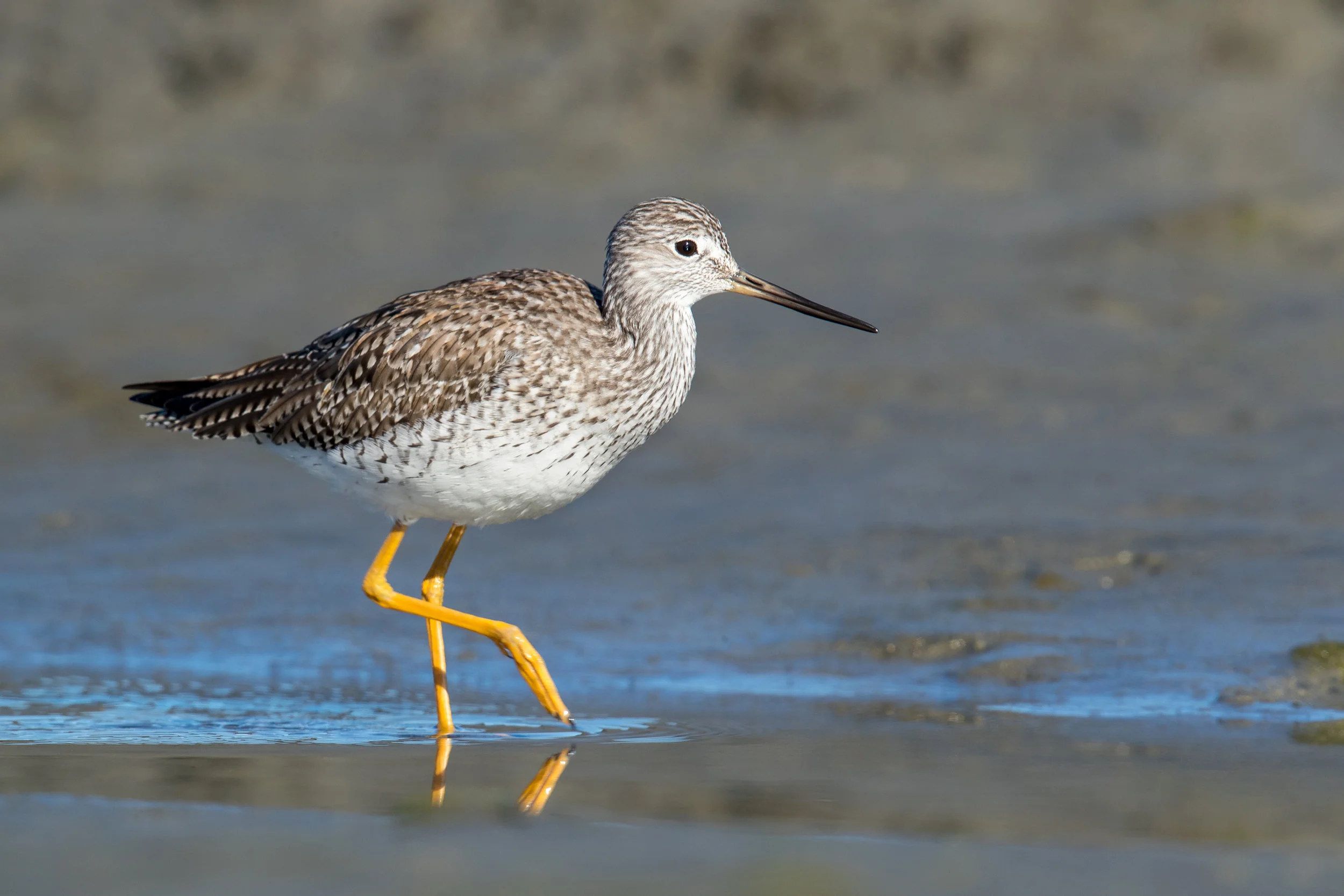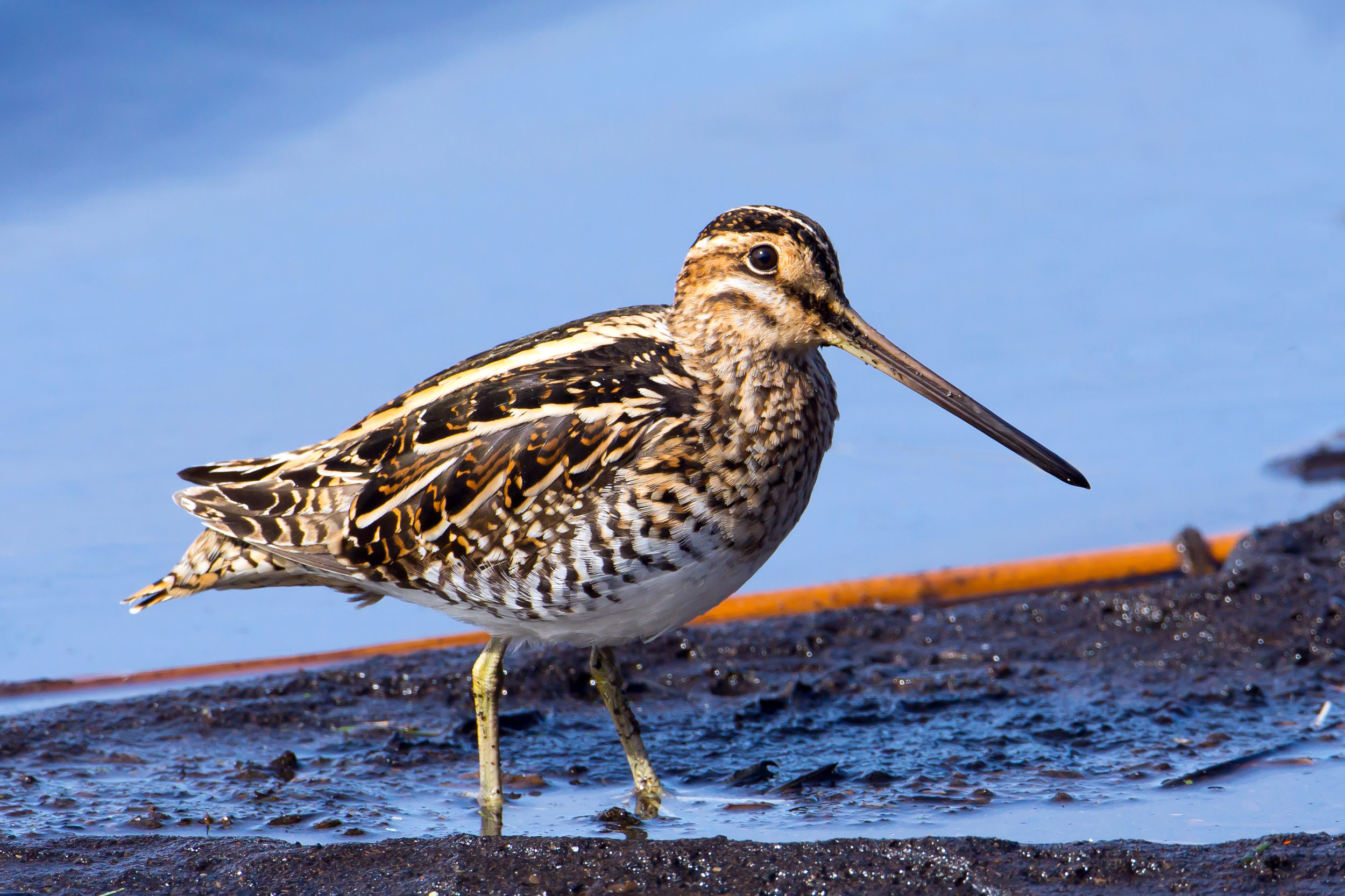Gallery - Shorebirds
The Ruddy Turnstone is a bird of the shorelines and is most often seen in Washington along the outer coast during spring and fall migration.
Most sightings of this Eastern Hemisphere sandpiper in North America are of juveniles in fall migration. One such visitor spent more than two weeks on the mudflats on the Seattle side of the SR 520 bridge from September 22 to October 10, 2022, sparking a newspaper story and interest from birders and nonbirders.
The Stilt Sandpiper blends the appearance of a yellowlegs with the behavior of a dowitcher. So much so, that some hunters in the 19th Century referred to it as the Bastard Yellowlegs.
A loner by nature, the Solitary Sandpiper is a regular but uncommon visitor to western Washington during spring and fall migrations.
The well-camouflaged Snowy Plover blends into its sandy surroundings, but Washington’s small population needs ongoing protection.
The Rock Sandpiper is one of Washington’s wintering shorebirds. It is seen with some regularity along the jetties at Westport and Brown’s Point in Ocean Shores, most often in the company of Surfbirds, Ruddy Turnstones and Black Turnstones, which also forage on rocky shores.
Dunlins are hardy birds that winter farther north than any other shorebird. This fall and winter they will be along the Washington coast from late October to early May. Major stopover points for them are the tidal flats and coastal estuaries around Willapa Bay and Grays Harbor and the Samish and Skagit Flats where they forage on marine and freshwater invertebrates by probing a few centimeters into the mud or fine-grained sand.
The Greater Yellowlegs (GRYE) is about 14” long with a wingspan of 28” while the Lesser is 10-11” long with a wingspan of 24”. The genus name Tringa (TRING-gah) is from Greek tryngas used by Aristotle for a white-rumped water bird.
Baird’s Sandpiper is not seen very often in Washington and because of this it poses an identification challenge for many birders. However, its slightly larger size when compared to other peeps; its lack of red or rufous coloration; and its penchant for foraging higher on beaches and in drier areas, all help to separate this peep from the others.
The Spotted Sandpiper is probably the most widespread breeding sandpiper in North America, but it is one of a very small minority of sandpipers with one of the least common gender roles. Females arrive on the breeding ground first and will display to attract the males as they arrive.
The Marbled Godwit (MAGO) is about 18" long with a 29" wingspan and weighs 13 oz. (370g). The genus name Limosa (lie-MOH-sah) is from the Latin limus, meaning "muddy," for its favorite habitat, mudflats. The species name fedoa (FED-oh-ah) is the Latin version of an old and now unknown English word meaning "marbled." - for its mottled plumage.
The Western Sandpiper is part of the genus Calidris from the Greek kalidris which was used by Aristotle for a speckled waterbird. Mauri is from Ernest Mauri (1791-1836) an Italian botanist and a friend of Charles Bonaparte (1803-1857), who named this bird for him. They co-authored a book on Italian fauna. The bird is the western counterpart to the Semipalmated Sandpiper Calidris pusilla and the common name designates this location.
These two lovely, golden-backed plovers are migratory visitors to Washington and are seen most often in the fall. They were once considered one species and are very similar in appearance and difficult to identify in the field. However, their beauty makes the task worthwhile.
The Willet (WILL) is about 15” long with a wingspan of 26” and a weight of 8 oz. (215g). The genus name Cataptrophorus (cat-op-TROW-for-us) is from Greek katoptron, mirror, and phoros, bearing, in reference to striking white pattern in the wings.
The Long-billed Dowitcher (LBDO) is about 11-1/2” long while the Short-billed Dowitcher (SBDO) is about 11” long. The wingspan for both is 19”. The genus name Limnodramus (lim-NOD-roh-mus) is Latin from the Greek limnodromos, marsh runner.
The Sanderling is the most widespread maritime shorebird wintering in North America. It is the common sandpiper of sandy beaches and is familiar to beach goers as it runs with whirring legs after waves and then retreats just as fast from the oncoming waves.
The Black-bellied Plover is our largest plover. It is distinctive in its breeding plumage with black bill and legs, back and white barred upperparts and black face, throat and breast to the belly. In fall it molts to its basic plumage of gray above and below with a lightly streaked breast (photo).
The Surfbird (SURF) is about 10” long with a wingspan of 26” and weight of 7 oz. (190 g). The genus name Aphriza (ah-FREE-zah) is from the Greek, aphros, froth, sea foam, meaning “to live in sea foam”.
The Wilson's Snipe (WISN) is about 11".(Its name was changed from Common Snipe, Gallinago gallinago, in 2002.) It is a secretive bird found in peat bogs, marshes, and wet fields.
n spring the Red Knot stands out on tidal flats in its bright chestnut plumage on its face, chest and belly. It has black legs and a black bill that is about as long as the head is wide (Paulson). By late July it will have molted to gray with a white belly and it easily blends in with other shorebirds and the colors of sand and vegetation along shorelines.
The Long-billed Curlew (LBCU) is about 23” with a wingspan of 35” and a weight of 1.3 lb. (590kg). The genus name Numenius (new-MEANihus)is Latin from the Greek noumenios, meaning the new moon: curve of bill likened to a new crescent moon. The species name americanus is Latin for America.
The Killdeer (KILL) is 9-11" in length. It is the only North American plover with two neck-rings. Coloring is dark brown above and white below. Its light reddish-brown rump is easily seen in flight or when the bird displays. The downy young have only one neck band.
The genus name Heteroscelus (heh-teh-ROSS-keh-lus) is from the Greek heteros, meaning “other” or “different”, and skelos, for “leg” which alludes to legs of this species being different from other sandpipers. The tarsus is scutellated instead of reticulated at the back. “Scutellated” is when the bare skin of the tarsus is a horny skin cut up into overlapping scales like shingles on a roof.
The genus name Numenius (new-MEAN-ih-us) is Latin from the Greek noumenios, of the new moon; curve of bill is likened to new crescent moon. The species name phaeopus (FEE-oh-pus) is from the Greek phaios, gray, and pous, foot, gray-foot. It was named Whimbrel in England from uttered note which sounded like whim. It is a member of the curlew family.
The species name tricolor (TRY-color) is Latin in reference to the three colors of this bird: white, black, and brown-red. The common name is in honor of Alexander Wilson, an early American ornithologist.
The Black Oystercatcher (BLOY) is 17-1/2” long. Its genus Haematopus (he-MAT-oh-pus) is from the Greek haimatopous for blood foot, brightly colored feet. The species name, bachmani, was given in 1838 by John James Audubon for his friend the Rev. John Bachman.
The species name melanocephala (mel-ah-no-SEFF-ah-lah) is from Greek melas, black, and kephale, head. “Turnstone” denotes the habit of these birds, and ruddy turnstones, of turning over, with its short, stout bill, stones, shells, seaweed and other objects in their search for food.
In the interior of North America the Least Sandpiper is the most common of the “peeps,” the small sandpipers in the genus Calidris. However, on the coast Least Sandpipers often associate with Western and Semipalmated Sandpipers and can be lost in their great numbers. Least Sandpipers generally travel in smaller flocks.
The Pectoral Sandpiper is uncommon in Western Washington but can usually be seen during fall migration. Adults begin passing through Washington in late July and juveniles show up from mid-August to late October. The juveniles will be in new plumage having completed their prejuvenile (or first prebasic) molt, which results in the change from downy feathers to their basic plumage.
The Semipalmated Plover is one of the most common plovers in North America and will attract attention in a flock of shorebirds when it repeatedly runs and stops while foraging for marine worms, crustaceans and small mollusks (Kaufman). It takes a particular stance when stopped.






























